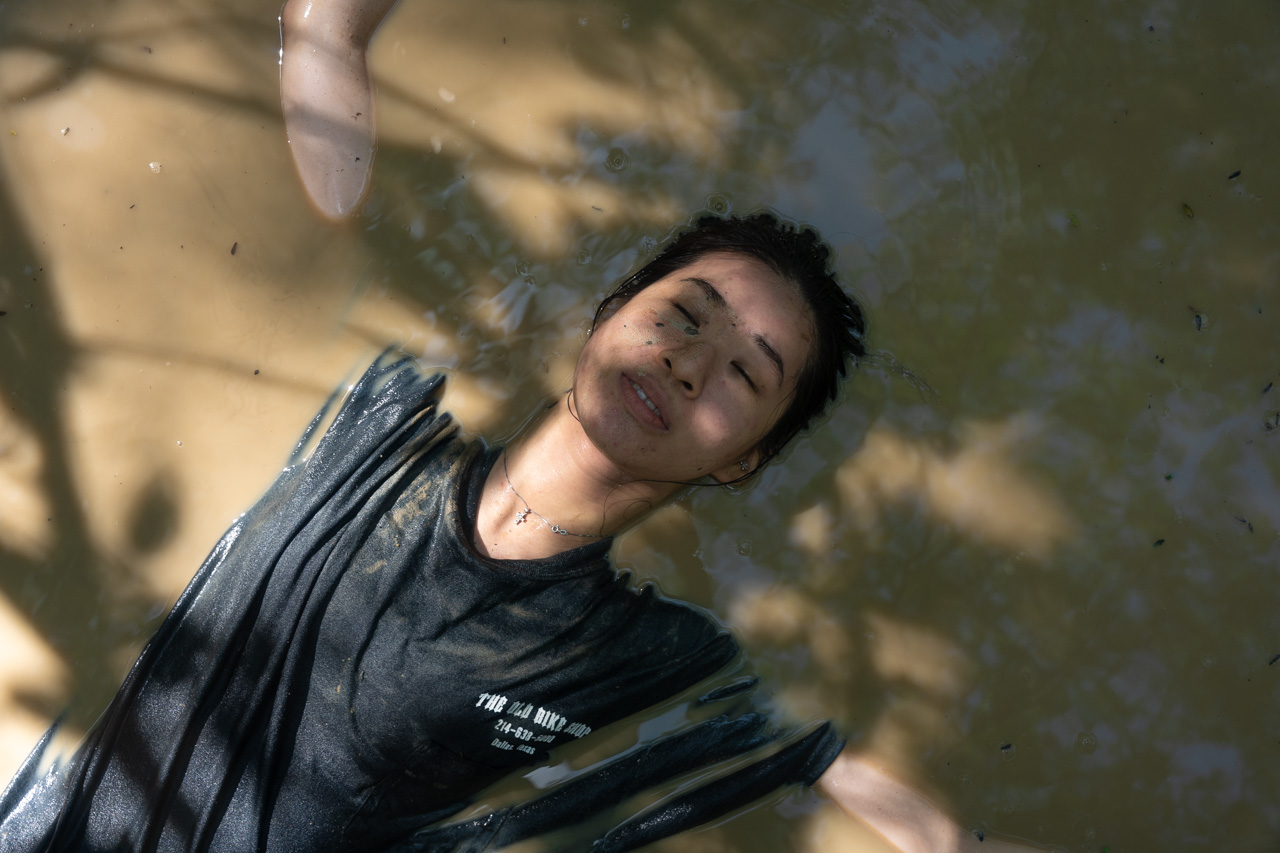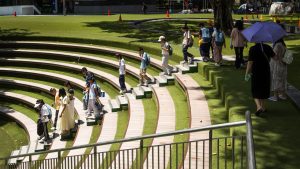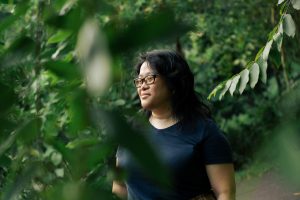All images by Shiva Bharathi Gupta for RICE Media unless otherwise stated.
I am lying in a frigid mud puddle in Tampines Quarry on a Thursday morning.
My face and chest are the only parts of my body peeking out. Everything else rests on the marshy ground, feeling lighter than usual thanks to the buoyancy of the milo peng-coloured water.
Somewhere to the left, my guide, Alan Ng, shifts and sends ripples of water my way.
“Welcome to the mud experience,” he says.
I can’t exactly see him because I’m staring up ahead at the sky. But I can hear the smile in his voice.
I wonder why we chose to do this. Then I remember that our little jaunt into the great muddy outdoors was my idea in the first place, prompted by growing discontent with a screen-heavy, nature-deficient life.
Nature’s Great. From Afar.
It wasn’t always like this. As a kid, I wasn’t afraid of rolling around on grass hills or going barefoot at the beach.
Maybe it’s all those cautionary articles (discarded needles at beaches, deadly bacteria in certain lakes, and all the diseases you can get from ticks) or my mum’s admonishments (apparently dogs pee on grass). But I slowly developed an aversion to being in nature the older I got.
Nowadays, my idea of enjoying the outdoors is occasionally working out of a McDonald’s where I have a panoramic view of Bishan Park. Close enough for me to feast my eyes on the greenery, but far enough away from heat, humidity and bugs.
So, when Alan’s Facebook post popped up in my feed, my fingers froze mid-scroll.
In a photo posted on Singapore Hikers—the online gathering spot for intrepid local explorers—was a man fully submerged in mud, floating peacefully like he was in one of those fancy sensory deprivation baths. A really earthy one, that is.
He didn’t accidentally fall into it; he was relishing the plunge. Declaring that he was “feeling fantastic” in his caption, Alan wrote:
“Some people think it’s the cure-all for everything from a hangover to a broken heart. But really, mud is nature’s Band-Aid.”
That’s a ringing endorsement, if any. I wanted to know—could bathing in Singapore’s forbidden teh really heal the soul?
The Man Who Bathes in Mud
When I get hold of Alan over a video call, he’s every bit as zen as I expected.
The 43-year-old has a day job working in events and logistics at People’s Association, but any chance he gets, you’ll find him out and about.
Of course, the man doesn’t just soak in mud. He rattles off his favourite hiking spots, both locally and regionally. Alan’s excited about a continuous 162km round-island walk planned next month—an expedition inspired by past attempts to do so.
“First, we went from 2km to 5km. And then slowly, we tried to push our limits. We went to 10km, 26km, and coast to coast, about 50 km. We tried to do it, and we realised we can actually do it.”
‘We’ refers to his hiking buddies, whom he met online during the pandemic.
Back when travel bans kicked in, Alan noticed a lot more people organising hiking expeditions around Singapore, and he joined a couple for the fun of it. The next thing he knew, he found himself a solid group of friends and was going on regular hikes every week.
“That’s how I sort of found back my childhood, you know? Like jumping into the mud, climbing trees and everything.”
Being more active also helped him shed about 30kg, he shares. Before the pandemic hit, he was “fat” and “not healthy”, he says.
But more than the reduced number on the scale, his reason for getting out (and jumping headfirst into mud puddles) is simple and primordial. It’s just to feel good.
“I find stress relief. I find my soul and my battery recharged, and I can go back to my work refreshed.”
That’s exactly the elusive feeling I’m after. 2022 wasn’t the most idyllic year for me—think the end of a long-term relationship, burnout that vacations can’t fix, and slowly intensifying existential dread. You know, the usual millennial crisis.
‘What’s the Mud Like?’
I meet Alan at Tampines Quarry, wearing my oldest clothes. Just in case I end up having to bin them.
My colleague Alistair joins us, also in his most tattered T-shirt. I count at least two holes on it.
He was game to come along when he heard about my mud bath pilgrimage. Who am I to say no to the extra victim company?
“So what exactly are we going to do? What’s the mud like?” he asked on our Grab ride to Tampines.
“You’ll see.”
I don’t think he knew that we’d be submerged in rainwater and dirt—not at all a spa-style experience. Poor guy.
He starts to catch on to what’s in store as Alan leads us down a well-trodden trail, side-stepping smaller puddles along the way.
It takes about 15 to 20 minutes of walking before we finally reach a point in the trail where the puddles start looking a lot more like plunge pools. We exchange wide-eyed glances as the reality of what we are about to do sinks in.
For centuries, mud has been used as a building material and a skin treatment. Yet the thought of touching it and soaking in it at its very source turns my stomach.
Alan, who has three sons aged two to 11, tells me that he notices a similar aversion to nature among parents nowadays.
While the parents of his generation were more than fine letting him run wild, he says parents are now more apprehensive and don’t even let their kids out in the rain.
“Our parents let us run in the rain. They said, ‘It’s okay. At most you’ll get sick.’ And after that, we’ll get stronger,” he says, adding proudly that he’s still COVID-free.
“Don’t keep restricting children, telling them they cannot do this, cannot do that. When they stay at home and play computer you’ll also nag.”
In fact, what’s clean, or being too clean, isn’t necessarily better for us. The hygiene hypothesis posits that growing up in environments that are too clean affects kids’ immune system development, and could explain why asthma is one of the most common chronic diseases in developed countries.
As Alan seeks out the perfect puddle that’s big enough for the three of us, he admits that the online response to his mud-bathing antics hasn’t been all positive. The most common concern is the possibility of ear infections. I can’t lie—that’s one of the lingering fears I’ve been trying hard to push to the back of my mind.
“I personally haven’t had any infections at all,” Alan assures.
He continues after a beat, perhaps still sensing our apprehension. “I believe that all this is natural. Our ancestors have been bathing in nature for generations, and nothing happened to them.”
I try to hold on to comforting thoughts while Alan begins his usual pre-mud bath ritual.
All he needs to do, he explains as he prods at the puddle with a stick, is make sure the area is clear of things like sharp rocks and snakes.
This is both reassuring and horrifying. Still, I’m glad that Alan is taking all precautions.
A frog pops its head out of the water from all the poking.
“It’s probably not a snake,” Alan offers.
Alistair and I almost want make a run for it by this point. Fortunately, it’s a frog. It hops away, and we don’t have to share our mud puddle with the critter.
“Imagine if we’d accidentally squashed it,” I joke. Alistair does not laugh.
One Small Leap
As we panic internally, Alan pitches backwards into the puddle with a spectacular splash. He lays there for a moment, looking very much at home, beckoning for us to join.
“Should we go in? I think we should go in,” I try to sound enthusiastic, since I was the one who’d suggested all of this in the first place.
“Yeah, we should, we should,” Alistair absent-mindedly agrees. We both stay rooted to the spot as we watch Alan enter zen mode, his eyes disappearing as he smiles. He’s sitting up now, looking like he’s just chilling in a hot tub.
Like swimmers taking their marks before a race, Alistair and I find our own little spots, psyche ourselves up, and count down.
“Three, two, one! RICE Media!” we shout, because we’re all about that company spirit.
I fall in first and Alistair follows a second later, his splash sending mud over my face, up my nose, and into my mouth. At that moment, I silently regret bringing him along.
All at once, I’m fully immersed in the puddle, and I involuntarily tense up. Maybe it’s the metallic odour of the water, or how it seeps into my clothes, or the small little bits of dead leaves and other debris brushing against my skin.
For the first time since childhood, I’m surrounded by pure, unfiltered dirt. All I want to do is rinse everything off, but I will myself to calm down.
Alistair is presumably going through the same emotions. I say “presumably” because all that’s coming from his mouth are unintelligible noises.
We cough, we laugh, we sputter.
Alistair breaks out some quotes from Predator (“If it bleeds, we can kill it”) but none of it means anything to Alan and me. From some speedy Googling, it appears that in the movie, Arnold Schwarzenegger slathers mud all over himself to hide his heat signature from some monster. A pretty apt reference, actually. Alistair gets all his quips out of his system.
But then, we all settle in and let the puddle take us, and I begin to understand just what Alan meant when he called it “nature’s Band-Aid”.
Soaking in the refreshingly cold mud puddle, everything else—my deadlines, anxieties, and worries—seems a little further away. It’s almost like the poor man’s version of cold water therapy.
“Isn’t this view great? You can’t get this view anywhere else,” Alan muses.
Looking straight up, the azure sky and tree branches are all I see. It’s not the rarest of views, but I get what Alan means. Lying spread-eagled on the forest floor, cool mud coating my body, it does hit differently.
Is Being in Nature, Well, Human Nature?
I’ll spare you the details of the post-mud bath clean-up. Just know that there was mud everywhere. And I really do mean everywhere.
But the experience left me with a tranquillity that lasted even after I’d washed the last bits of mud down the shower drain.
If you’re thinking of hunting down your own mud puddle, I do have to warn you that your mileage might vary. Alistair, for example, is slightly traumatised by the whole thing, I gather.
While he’s too nice to actually complain about it, he does send me a link to a YouTube video a couple of days after our mud soak. It’s about the brain-eating amoebas of Kerosene Creek. Message received.
Maybe frolicking in the dirt is a bit much for the average Singaporean, but reconnecting with nature can be as simple as taking a walk in a park.
We don’t need studies to tell us the mental and physical benefits of spending time in nature—we can all feel it. But there are studies, and most of them say that nature connectedness has positive effects such as better concentration, calmness, and happiness levels.
Unfortunately, because it’s also human nature to stray away from what’s good for us in favour of what’s easily accessible (screens and technology), people are interacting less with nature over the last few decades.
To seek out wilderness in our city requires a deliberate effort. And as someone who’s opted for food delivery over walking to the nearest hawker centre because it’s hot outside, I’m well-aware that I’m part of the problem.
Our growing disconnect with nature has an official name—Nature-Deficit Disorder—coined by author and journalist Richard Louv.
Nature-Deficit Disorder isn’t an actual diagnosis, Richard says. But it can be used to describe the various symptoms of being alienated from nature: Dulled senses, attention problems, obesity, and Vitamin D deficiency. Fortunately, these maladies can be reversed, simply by going outdoors more.
Alan concurs on the healing effects of the outdoors, telling us that he’s seen changes for the better since he’s started bringing his boys out on more hikes.
His eight-year-old is mild-mannered and “hardly speaks”, but the little tyke recently discovered his talent for climbing mountains. Alan proudly calls him a “mountain goat”.
Even as an adult, the monotony of urban life can take its toll. As I’m writing this down, I’m already craving a break where I can spend a little more time outdoors.
My few minutes in a muddy puddle were enough to jolt my system and recharge my batteries for the day ahead. I did, however, have to battle the more rational side of me that kept thinking up reasons to get out of the mud. One of them was my paranoia over brain-eating amoeba every time I felt the trickle of water in my ear.
It was also something of a personal milestone. I was afraid, but I did it. And nothing bad happened (so far).
Seeking Wilderness in a City
Throwing yourself into the thick of wild, unbridled nature is a rare opportunity. But, at least in recent years, it seems as if Singaporeans are yearning for it.
Spots like Dover Forest and Clementi Forest have become increasingly popular. Unlike our national parks, these forests boast thick, unrestrained foliage without conveniently-paved paths.
Several forest schools have also popped up, where kids learn about Singapore’s flora and fauna, and get their hands dirty with other nature-themed crafts. The fact that parents are enrolling their kids in these schools is significant—it shows that they recognise being outdoors as an essential area in their child’s development.
And for some, myself included, spending time in nature serves as an escape from the hustle and bustle of life.
As we leave Tampines Quarry, we spot more people there enjoying the peace and quiet. One man has his car stopped by the roadside, and he’s just enjoying a cigarette on a foldable chair. A couple more people walk past us, clearly on the tail end of their morning hike.
Alan thanks us for our outing, his enthusiasm overflowing from introducing a couple more people to his offbeat routine.
He tells us he’s working on getting more from his hiking group on board.
“Actually some of them are slowly being converted. They are okay with all these—trees, forests, mud. They are slowly changing.”
I guess I am too. As I write this, it’s been nearly a week since my excursion into the great outdoors. I am typing up this article from my seat in McDonald’s, once again in sweet, sweet air-conditioned comfort. But maybe when I’m done, I’ll finish the rest of my coffee on the grass patch outside.





